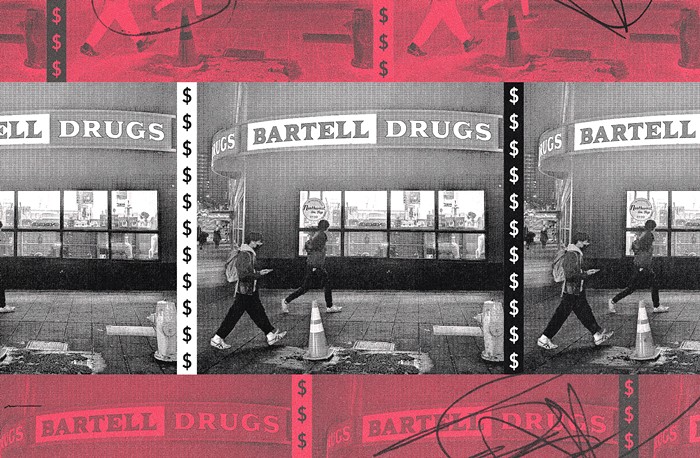
Green Lake's small craft center is about to get an estimated $6.5 million remodel. That should happen sometime in 2019. The remodel will add a second floor and more boat storage. It will be surprisingly swanky, according to the 3D views in this Parks and Rec powerpoint. Its splendor, however, is dwarfed by the history of its neighboring Aqua Theater.
There are only skeletal remains left of the once-grand Green Lake amphitheater. The current craft center rests on a plot of land where more than 5,000 people watched synchronized swimming, water ballet, and rock concerts from 1950 to 1970. It was started during Seattle's first Seafair. But, just like other old Seafair traditions at Green Lake, the shows at the Aqua Theater ceased.
In 1984, hydroplane races on Green Lake—a tradition since the '20s and popularized during Seafair—were banned. The races drew large crowds and the ire of the surrounding neighborhood. The noise, to them, was cacophonous. People complained. Sasha, a five-year-old snow leopard, gave birth to two cubs that summer at the Woodland Park Zoo. She also gave unhappy Green Lake residents a cause. The rumbling purr of the hydroplane engines darting across the lake distracted Sasha, she kept looking to the sky and couldn't juggle investigating that mystery and mothering her cubs. Two weeks later, one was dead. Curiosity had killed the cat, neighbors claimed. Community uproar ensued. Hydroplanes were forbidden. Green Lake returned to the idyllic, sleepy quiet it preferred.

The Green Lake Aqua Theater reached a climactic, but less controversial, demise. Built in 1950 in just 67 days for the Seafair summer festival, the amphitheater was amphibious; the stands were on land, but the stage rested on the water. A swimming pool lay in between like some kind of moat. It was like a Sea World performance but with less animal cruelty. Two 40-foot-tall diving towers bookended the stage. It was built primarily as the venue for the Aqua Follies where they performed “swimusicals” which mixed water ballet, stage dancing, and comedy into one wet bundle.
"Following a fireworks finale, [the] first performance of a 10-day stand ushered in a 15-year love affair between summertime theatergoers and Seattle's unique lakeside showplace," reads the History Link article about the theater.

The Aqua Theater, which could fit 5,582 in its final form, saw a heap of activity. There were musicals ranging from South Pacific to Oklahoma. An opera company would host "Music Under the Stars" on summer evenings at the theater and perform operettas. The accompanying orchestra would play in the floating orchestra pit. The peak in activity came during '62 when Seattle was the belle of the ball worldwide during the World's Fair. Huge crowds flocked to the city and filled the stands at the Aqua Theater. There were jazz festivals, musicals, and a whole week of Bob Hope! It was the height of the theater's short lifespan.
Soon thereafter, Seattle's unpredictable weather made performing outside on a wet stage a gamble. Attendance declined, profitability dwindled. The rain, intermittently, kept falling.
There was a brief resurgence when Led Zeppelin and the Grateful Dead stopped by in the summer of '69. People packed in like sardines to see each of those shows. Some treaded water in the pool the whole time, others rented paddle boats and watched for free from the lake. Tragically, no journalists recorded Zep's setlist for the show, according to History Link. Months later, inspections showed that there was significant structural damage to the venue. The Grateful Dead played anyway. You can listen to that performance here. After that, it was curtains for the Aqua Theater. All but a piece of the grandstand was torn down in 1970.
Stage right is now a pedestrian pier. Stage left is for crew shells—there’s a dock and that small craft house is used for storage. That $6.5 million remodel will better serve Green Lake’s rowers and paddlers in the boating community, according to that Parks and Rec powerpoint. What’s left of the Aqua Theater won’t be touched. Its original purpose may, however, be further obfuscated.
It came to light in the midst of the anti-hydroplane hubbub that Sasha the snow leopard's cub was premature and had a bacterial infection. A veterinarian concluded that hydroplane noise did not kill the cub. Residents still believed in the fake connection. For many, this was and would be the reason hydroplanes were banned. The Aqua Theater's demise wasn't so cut and dry—it was wear and tear, or it was Led Zeppelin, or it was the weather, or, irrelevance—but regardless, it's not dead yet.
The fraction of an amphitheater is still standing at the south end of Green Lake. It juts out of the earth, a lone concrete sliver. It’s weather-worn and weary. What do we watch here now? There’s a big green ‘G’ emblazoned on the stands in cracked paint. It’s like the home field for some high school that doesn’t exist. The seats face the lake water. Maybe the lake itself is the intended spectator sport.
Aqua Theater (Seattle, Green Lake)
A previous version of this post stated that a remodel would be $100,000. That was the cost of the feasibility and pre-design study. Whoops.















